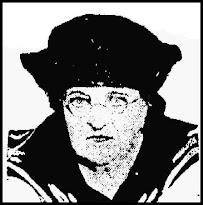1925: More of Lucy Hagenow's handiwork
Elizabeth Welter moved from Sturgeon Bay, Wisconsin to Chicago in the fall of 1924. On September 14, 1925, the 19-year-old clerk died at John B. Murphy Hospital from complications of an abortion perpetrated about a week earlier.
Mrs. Alta Vail told the deputy coroner, "Elizabeth roomed at 658 Roscoe street. A week ago she came to me and said she was very sick. I told her to stay at my home until she was better. Little by little she told me her story. She had obtained a position as a clerk in a store. Some months ago she began going out with a man. This man, she said, was responsible for her condition. She did not even know his name, she told me."
Lawrence Vail -- who according to 1930 census records was Alta's husband -- was identified by the coroner as responsible for the pregnancy, and the coroner recommended his arrest, along with the arrest of known abortionist Dr. Lucy Hagenow.
Hagenow was held to the grand jury on $20,000 bond (nearly $150,000 in 2020 dollars). However, because Vail refused to give a statement, police were unable to gather enough evidence to prosecute. Elizabeth was the 17th of 18 abortion deaths that have been connected to Hagenow. (See newly-added sources below.)
A tragic case from Colonial America
The oldest case I have in the Cemetery of Choice is the 1742 death of 19-year-old Sarah Grosvenor. Her story is recounted extensively in public records, but begins, predictably, with a lover who didn't love her enough to marry her once she was pregnant with his child. Sarah's family rallied around her, trying to save both her life and her reputation, but by the time they realized that she was pregnant and in the middle of an herbal abortion, the die was cast. Though Dr. John Hallowell shut himself in the room with Sarah on several occasions to provide some sort of care, Sarah breathed her last on September 14.
Her death-dealing abortionist had always been a marginal practitioner who lived a lot of his life on the wrong side of the law. Her faithless lover had been a high-standing member of the community. Sarah was buried, and life in the little town went on.
Suddenly, about a year after Sarah's death, warrants were issued for the arrests of the culpable parties and a hearing was held, determining that Hallowell was guilty of murder, and that Sarah's lover, Amasa Sessions, was an accessory. This was a preliminary finding, and called for prosecution. At first the case -- against Hallowell, at least -- was pushed vigorously. Hallowell was found guilty and sentenced to be shamed, whipped, and imprisoned. He escaped before this sentence could be carried out, and vanished from public view. Nobody went to any trouble to find him.
As for Amassa Sessions, he regained his fine standing in the community, married, and fathered a house full of children before dying at a ripe old age. Reading the laudatory inscription on his headstone, one can almost hear the weeping of the mourners, the family and distinguished persons of the town, as they lay Amasa Sessions, pillar of the community, to rest. Less than 25 feet away lay Sarah Grosvenor, nearly 50 years dead -- evidently forgotten.
Her death-dealing abortionist had always been a marginal practitioner who lived a lot of his life on the wrong side of the law. Her faithless lover had been a high-standing member of the community. Sarah was buried, and life in the little town went on.
Suddenly, about a year after Sarah's death, warrants were issued for the arrests of the culpable parties and a hearing was held, determining that Hallowell was guilty of murder, and that Sarah's lover, Amasa Sessions, was an accessory. This was a preliminary finding, and called for prosecution. At first the case -- against Hallowell, at least -- was pushed vigorously. Hallowell was found guilty and sentenced to be shamed, whipped, and imprisoned. He escaped before this sentence could be carried out, and vanished from public view. Nobody went to any trouble to find him.
As for Amassa Sessions, he regained his fine standing in the community, married, and fathered a house full of children before dying at a ripe old age. Reading the laudatory inscription on his headstone, one can almost hear the weeping of the mourners, the family and distinguished persons of the town, as they lay Amasa Sessions, pillar of the community, to rest. Less than 25 feet away lay Sarah Grosvenor, nearly 50 years dead -- evidently forgotten.
Watch A Colonial Era Death and Another Victim of Lucy Hagenow on YouTube.
NEWLY ADDED SOURCES
Elizabeth Welter:
- "Girl's Brief Fling With City Night Life," Mattoon (IL) Journal Gazette, September 14, 1925
- "Woman Surgeon Sought Following Girl's Death," Chicago Tribune, September 15, 1925
- "Lucy Hagenow, Midwife, Held in Death of Girl," Chicago Tribune, September 16, 1925

No comments:
Post a Comment